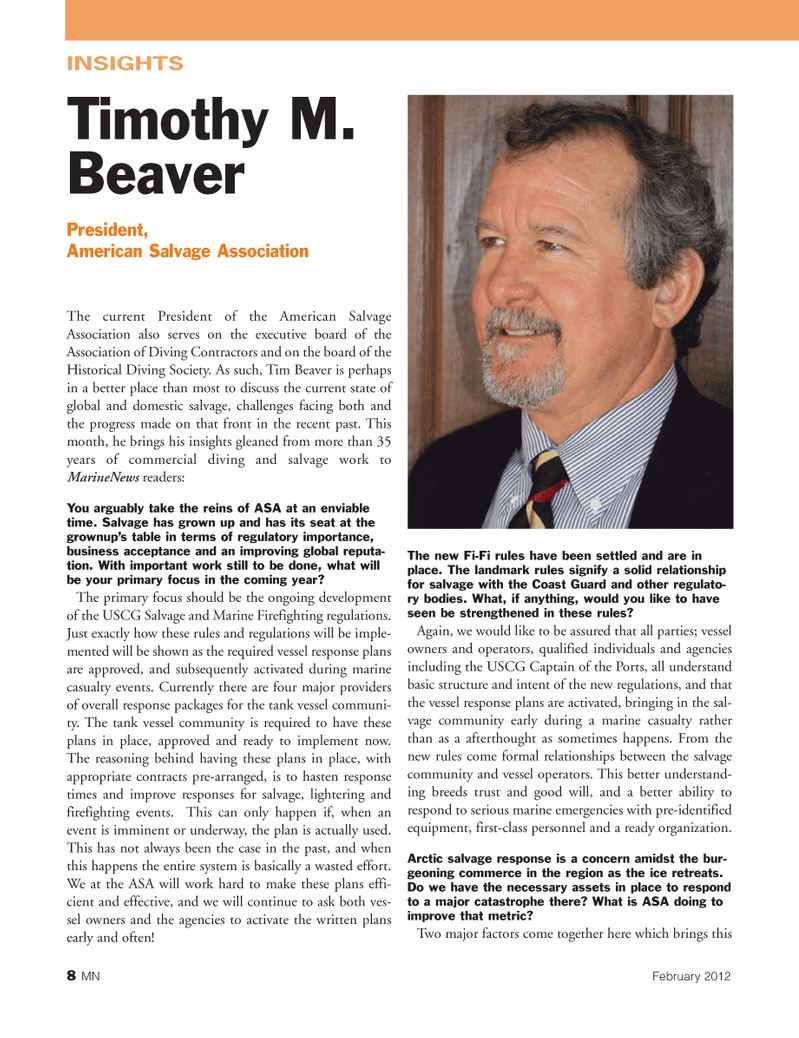
Page 8: of Marine News Magazine (February 2012)
Inland Bulk Transportation
Read this page in Pdf, Flash or Html5 edition of February 2012 Marine News Magazine
8MNFebruary 2012 INSIGHTSThe current President of the American Salvage Association also serves on the executive board of the Association of Diving Contractors and on the board of the Historical Diving Society. As such, Tim Beaver is perhaps in a better place than most to discuss the current state of global and domestic salvage, challenges facing both and the progress made on that front in the recent past. This month, he brings his insights gleaned from more than 35 years of commercial diving and salvage work to MarineNews readers: You arguably take the reins of ASA at an enviable time. Salvage has grown up and has its seat at the grownup?s table in terms of regulatory importance, business acceptance and an improving global reputa- tion. With important work still to be done, what will be your primary focus in the coming year?The primary focus should be the ongoing development of the USCG Salvage and Marine Firefighting regulations. Just exactly how these rules and regulations will be imple- mented will be shown as the required vessel response plans are approved, and subsequently activated during marine casualty events. Currently there are four major providers of overall response packages for the tank vessel communi- ty. The tank vessel community is required to have these plans in place, approved and ready to implement now. The reasoning behind having these plans in place, with appropriate contracts pre-arranged, is to hasten response times and improve responses for salvage, lightering and firefighting events. This can only happen if, when an event is imminent or underway, the plan is actually used. This has not always been the case in the past, and whenthis happens the entire system is basically a wasted effort. We at the ASA will work hard to make these plans effi- cient and effective, and we will continue to ask both ves- sel owners and the agencies to activate the written plans early and often!The new Fi-Fi rules have been settled and are in place. The landmark rules signify a solid relationship for salvage with the Coast Guard and other regulato- ry bodies. What, if anything, would you like to haveseen be strengthened in these rules? Again, we would like to be assured that all parties; vessel owners and operators, qualified individuals and agencies including the USCG Captain of the Ports, all understand basic structure and intent of the new regulations, and that the vessel response plans are activated, bringing in the sal- vage community early during a marine casualty rather than as a afterthought as sometimes happens. From the new rules come formal relationships between the salvage community and vessel operators. This better understand- ing breeds trust and good will, and a better ability to respond to serious marine emergencies with pre-identified equipment, first-class personnel and a ready organization. Arctic salvage response is a concern amidst the bur- geoning commerce in the region as the ice retreats. Do we have the necessary assets in place to respond to a major catastrophe there? What is ASA doing to improve that metric? Two major factors come together here which brings this Timothy M. BeaverPresident, American Salvage AssociationMN#2 (1-17):MN 2011 Layouts 2/3/2012 11:20 AM Page 8

 7
7

 9
9
